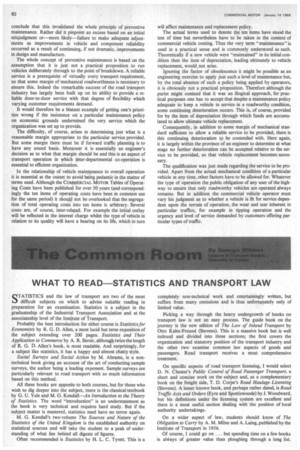WHAT TO READ STATISTICS AND TRANSPORT LAW
Page 84

If you've noticed an error in this article please click here to report it so we can fix it.
STATISTICS and the law of transport are two of the most difficult subjects on which to advise suitable reading in preparation for an examination. Statistics is a subject in the graduateship of the Industrial Transport Association and at the associateship level of the Institute of Transport.
Probably the best introduction for either course is S tatistics for Economists by R. G. D. Allen, a most lucid but terse exposition of the subject extending over 200 pages. Statistics and Their Application to Commerce by A. R. Ilersic, although twice the length of R. G. D. Allen's book, is most readable. And surprisingly, for a subject like statistics, it has a happy and almost chatty style.
Social Surveys and Social Action by M. Abrams, is a nontechnical book giving an account of the art of conducting sample surveys, the author being a leading exponent. Sample surveys are particularly relevant to road transport with so much information based on this method.
All these books are apposite to both courses, but for those who wish to dig deeper into the subject, there is the classical textbook by G. U. Yule and M. G. Kendall—An Introduction to the Theory of Statistics. The word "introduction" is an understatement as the book is very technical and requires hard study. But if the subject matter is mastered, statistics need have no terror again.
M. G. Kendall's two-volume The Sources and Nature of the Statistics of the United Kingdom is the established authority on statistical sources and will take the student to a peak of understanding of what lies behind all digests of figures.
Often recommended is Statistics by H. L. C. Tyrett. This is a
completely non-technical work and entertainingly written, but suffers from many omissions and is thus unfortunately only of limited value.
Picking a way through the heavy undergrowth of books on transport law is not an easy process. The guide book on the journey is the new edition of The Law of Inland Transport by Otto Kahn-Freund (Stevens). This is a massive book but is well indexed and divided into three sections; the first covers the organization and statutory position of the transport industry and the other two examine common law aspects of goods and passengers. Road transport receives a most comprehensive treatment.
On specific aspects of road transport licensing, I would select D. N. Chester's Public Control of Road Passenger Transport, a short and concise work on the subject and, as a complementary book on the freight side, T. D. Corpe's Road Haulage Licensing (Stevens). A lesser known book, and perhaps rather dated, is Road Traffic Acts and Orders (Eyre and Spottiswoode) by J. Woodward, but his definitions under the licensing system are excellent and there is a most useful section dealing with the position of local authority undertakings.
On a wider aspect of law, students should know of The Obligation to Carry by A. M. Milne and A. Laing, published by the Institute of Transport in 1956.
Of course, I could go on. .. but spending time on a few books is alWays of greater value than ploughing through a long list.
















































































































































